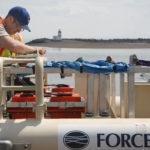Joel Culina & Melissa Oldreive, Fundy Ocean Research Center for Energy (FORCE)
Mapping a flow field consists of the measurement of currents and eddies in time and space. This is a key endeavour in support of the tidal stream technology sector, which requires detailed knowledge of the flow field for resource assessment, for understanding the environmental impact of tidal devices. Although there are relatively established methods for measuring velocity at a single point in horizontal space (e.g., with ADCPs), observations over horizontal space (e.g., of large eddies swirling through the FORCE region) are very limited and very difficult to obtain. An extremely promising and cost-effective technology for this purpose is the use of shore-mounted X-band, or marine, radar. This type of radar, common to marine vessels, generates ‘sea clutter’ which is typically discarded for navigational purposes but contains highly detailed information of the sea surface conditions. This information can be used to accurately infer the two-dimensional surface current velocity field and the presence of metres-scale eddies. One such radar has already been deployed on the Fundy Ocean Research Center for Energy (FORCE) Visitor’s Centre to map the FORCE region waters. A second, trial radar is presently being deployed on Cape Sharp headland to map the eastern portion of Minas Passage. The goal is to establish a network of radars to live-map the flow features through all of Minas Passage.

